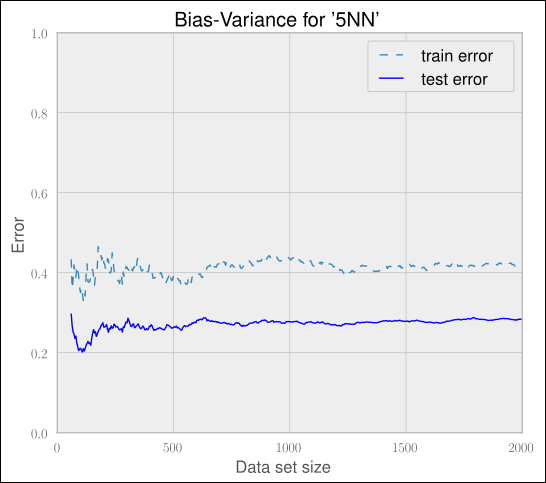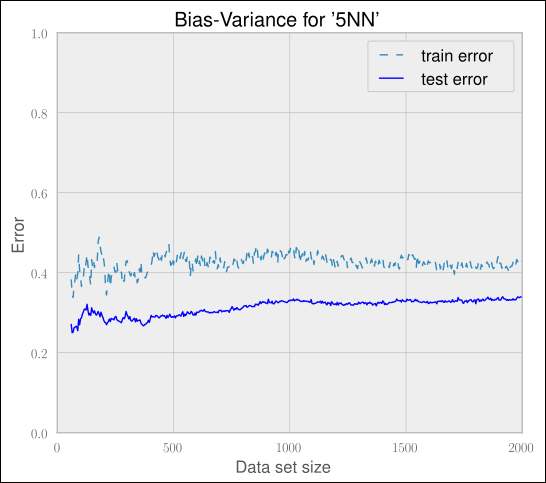To improve on this, we basically have the following options:
- Add more data: It may be that there is just not enough data for the learning algorithm and that we simply need to add more training data.
- Play with the model complexity: It may be that the model is not complex enough or is already too complex. In this case, we could either decrease k so that it would take less nearest neighbors into account and thus would be better at predicting non-smooth data, or we could increase it to achieve the opposite.
- Modify the feature space: It may be that we do not have the right set of features. We could, for example, change the scale of our current features or design even more new features. Or rather, we could remove some of our current features in case some features are aliasing others.
- Change the model: It may be that kNN is generally not a good fit for our use case, such that it will never be capable of achieving good prediction performance no matter how complex we allow it to be and how sophisticated the feature space will become.
In real life, at this point, people often try to improve the current performance by randomly picking one of the preceding options and trying them out in no particular order, hoping to find the golden configuration by chance. We could do the same here, but it will surely take longer than making informed decisions. Let's take the informed route, for which we need to introduce the bias-variance tradeoff.
In Chapter 1, Getting Started with Python Machine Learning, we tried to fit polynomials of different complexities controlled by the dimensionality parameter, d, to fit the data. We realized that a two-dimensional polynomial, a straight line, did not fit the example data very well because the data was not of a linear nature. No matter how elaborate our fitting procedure would have been, our two-dimensional model will see everything as a straight line. We say that it is too biased for the data at hand; it is under-fitting.
We played a bit with the dimensions and found out that the 100-dimensional polynomial was actually fitting very well into the data on which it was trained (we did not know about train-test splits at the time). However, we quickly found that it was fitting too well. We realized that it was over-fitting so badly that with different samples of the data points, we would have gotten totally different 100-dimensional polynomials. We say that the model has too high a variance for the given data or that it is over-fitting.
These are the extremes between which most of our machine learning problems reside. Ideally, we want to have both low bias and low variance. But, we are in a bad world and have to trade off between them. If we improve on one, we will likely get worse on the other.
Let us assume that we are suffering from high bias. In this case, adding more training data clearly will not help. Also, removing features surely will not help as our model is probably already overly simplistic.
The only possibilities we have in this case is to either get more features, make the model more complex, or change the model.
If, on the contrary, we suffer from high variance that means our model is too complex for the data. In this case, we can only try to get more data or decrease the complexity. This would mean to increase k so that more neighbors would be taken into account or to remove some of the features.
To find out what actually our problem is, we have to simply plot the train and test errors over the data size.
High bias is typically revealed by the test error decreasing a bit at the beginning, but then settling at a very high value with the train error approaching a growing dataset size. High variance is recognized by a big gap between both curves.
Plotting the errors for different dataset sizes for 5NN shows a big gap between the train and test error, hinting at a high variance problem. Refer to the following graph:

Looking at the previous graph, we immediately see that adding more training data will not help, as the dashed line corresponding to the test error seems to stay above 0.4. The only option we have is to decrease the complexity either by increasing k or by reducing the feature space.
Reducing the feature space does not help here. We can easily confirm this by plotting the graph for a simplified feature space of LinkCount and NumTextTokens. Refer to the following graph:

We will get similar graphs for other smaller feature sets as well. No matter what subset of features we take, the graph will look similar.
At least reducing the model complexity by increasing k shows some positive impact. This is illustrated in the following table:
|
k |
mean(scores) |
stddev(scores) |
|---|---|---|
|
90 |
0.6280 |
0.02777 |
|
40 |
0.6265 |
0.02748 |
|
5 |
0.5765 |
0.03557 |
But this is not enough, and it comes at the price of lower classification runtime performance. Take, for instance, the value of k = 90, where we have a very low test error. To classify a new post, we need to find the 90 nearest other posts to decide whether the new post is a good one or not:

Clearly, we seem to be facing an issue with using the nearest neighbor algorithm for our scenario. It also has another real disadvantage. Over time, we will get more and more posts to our system. As the nearest neighbor method is an instance-based approach, we will have to store all the posts in our system. The more posts we get, the slower the prediction will be. This is different with model-based approaches where you try to derive a model from the data.
So here we are, with enough reasons now to abandon the nearest neighbor approach and look for better places in the classification world. Of course, we will never know whether there is the one golden feature we just did not happen to think of. But for now, let's move on to another classification method that is known to work great in text-based classification scenarios.
